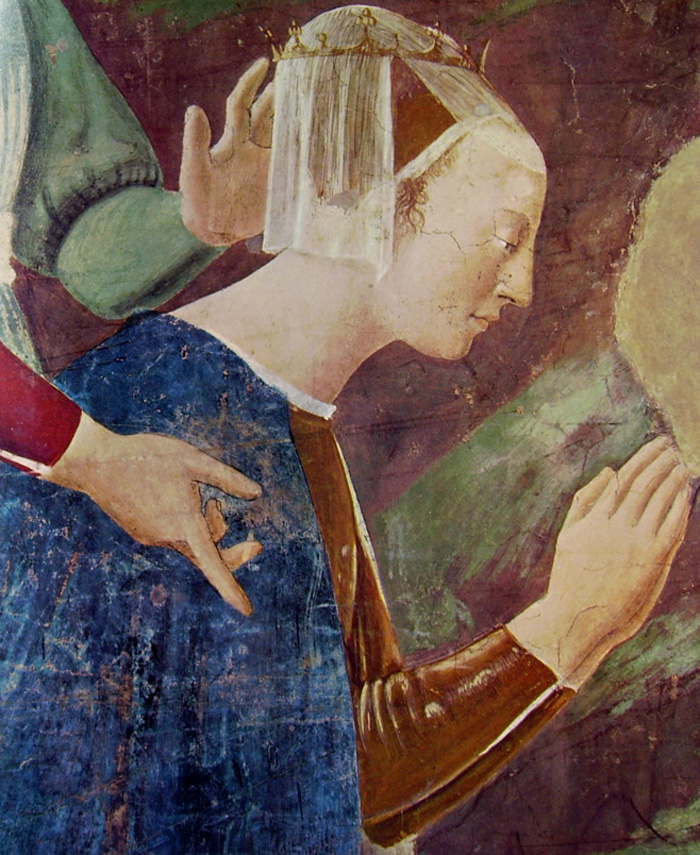| |
|
| |
|
|
|
|
|
|
| |
 |
 |
|
Piero della Francesca, Piero della Francesca, Adoration of the Holy Wood and the Meeting of Solomon and the Queen of Sheba,
Basilica di San Francesco, Arezzo [2]
|
|
 |
|
| |
|
|
|
| |
|
Piero della Francesca | Adoration of the Holy Wood and the Meeting of Solomon and the Queen of Sheba
|
|
|
|
| |
|
Chiesa di S. Francesco | Church of SaintFrancis of Assisi
The famous Church of San Francesco is named after the 13th century founder of the Franciscan order who is also Italy’s patron saint. The church is located in the piazza or plaza by the same name and is renowned for containing the precious and irreplaceable frescoes known as The Legend of the True Cross, by Early Renaissance master painter Piero della Francesca.
The stone-walled basilica, in the heart of Arezzo’s historic centre, was originally built during the second half of the 13thcentury. Its current look, redesigned by 14th century Tuscan Gothic architects, was inspired by the Domenican orders’ call for aesthetic simplicit. Inside, its broad single nave or main aisle is flanked on the right by small shrines with 14th century and Renaissance era ornaments and on the left, by the characteristically Gothic ogival or pointed arches with small chapels. The centrepiece of this rather humble church, and what attracts thousands of visitors every year, is the sequence of frescoes that line the walls of the apse or rounded end of the church.The Legend of the True Cross is Piero della Francesca’s largest, and, many critics say, his finest masterpiece. Painted between 1453 and 1464, the frescoes contain many religious scenes described in a 13thcentury book on the lives of saints. Scenes include: Death of Adam, the Meeting of Solomon and the Queen of Sheba, and the Battle between Heraclius and Khosrau.
Thos page focusses on
|
The Queen of Sheba
The Queen of Sheba is a queen regnant who appears in the Bible. The tale of her visit to King Solomon has undergone extensive Jewish, Arabian and Ethiopian elaborations, and has become the subject of one of the most widespread and fertile cycles of legends in the Orient.[1]
The reception of the queen was a popular subject during the Italian Renaissance. It appears in the bronze doors to the Florence Baptistery by Lorenzo Ghiberti, in frescoes by Benozzo Gozzoli (Campo Santo, Pisa) and in the Raphael Loggie (Vatican). Examples of Venetian art are by Tintoretto (Prado) and Veronese (Pinacotheca, Turin). In the 17th century, Claude Lorrain painted The Embarkation of the Queen of Sheba (National Gallery, London).[4]
Piero della Francesca's frescoes in Arezzo (ca. 1466) on the Legend of the True Cross contain two panels on the visit of the Queen of Sheba to Solomon. The legend links the beams of Solomon's palace (adored by Queen of Sheba) to the wood of the crucifixion.
|
Adorazione della Croce e incontro tra Salomone e la Regina di Saba
|
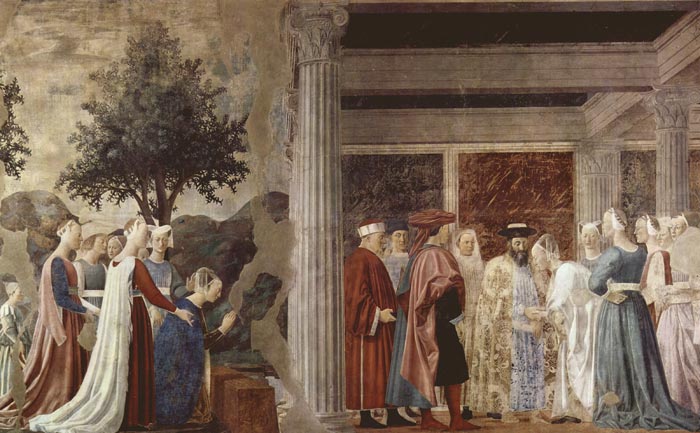 |
Piero della Francesca, Piero della Francesca, Adoration of the Holy Wood and the Meeting of Solomon and the Queen of Sheba,
Basilica di San Francesco, Arezzo
|
|
|
|
According to the legend, the Queen of Sheba worshiped the beams made from the tree, and informed Solomon, that the Saviour would hang from that tree, and thus dismember the realm of the Jews. This caused Solomon to hew it down and bury it, until it was found by the Romans.
Queen of Sheba's encounter with Solomon takes place in a temple-like structure. Solomon stands with his courtiers; the queen, entering from the right, deferentially bows to him. The queen prophesied to Solomon that the dominion of the Jews would one day be destroyed by the man who would hang from that beam. Solomon's response was to have the beam sunk in a well.
The two episodes are shown in the same fresco, separated from each other by the column of the royal palace: the Procession of the Queen of Sheba is on the left, the Meeting between the Queen of Sheba and King Solomon on the right.
|
|
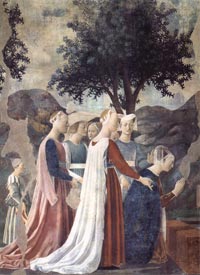
|
Adoration of the Holy Wood
|
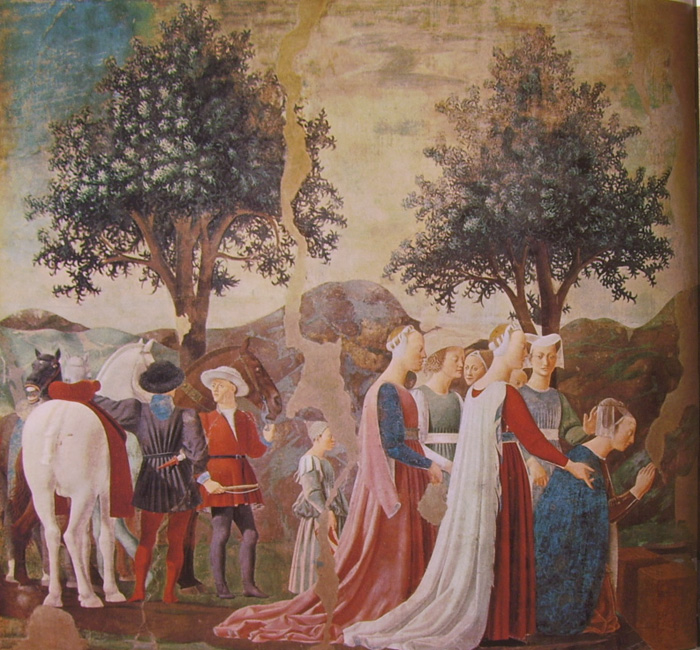
|
Piero della Francesca, Piero della Francesca, Adoration of the Holy Wood, Basilica di San Francesco, Arezzo
|
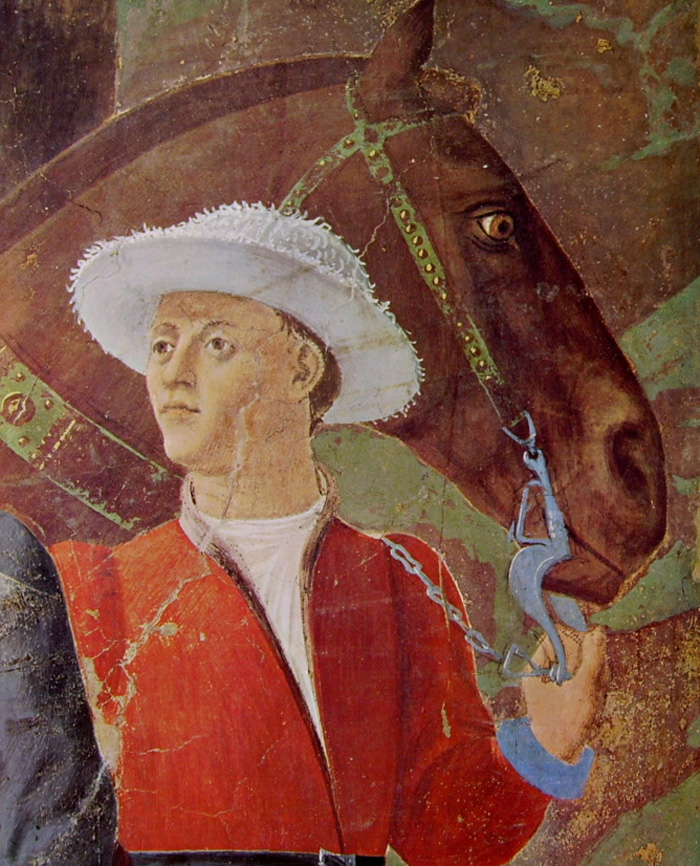 |
Piero della Francesca, Adoration of the Holy Wood (detail, , Basilica di San Francesco, Arezzo
|
| |
|
|
|
| |
|
Meeting of Solomon and the Queen of Sheba
|
|
|
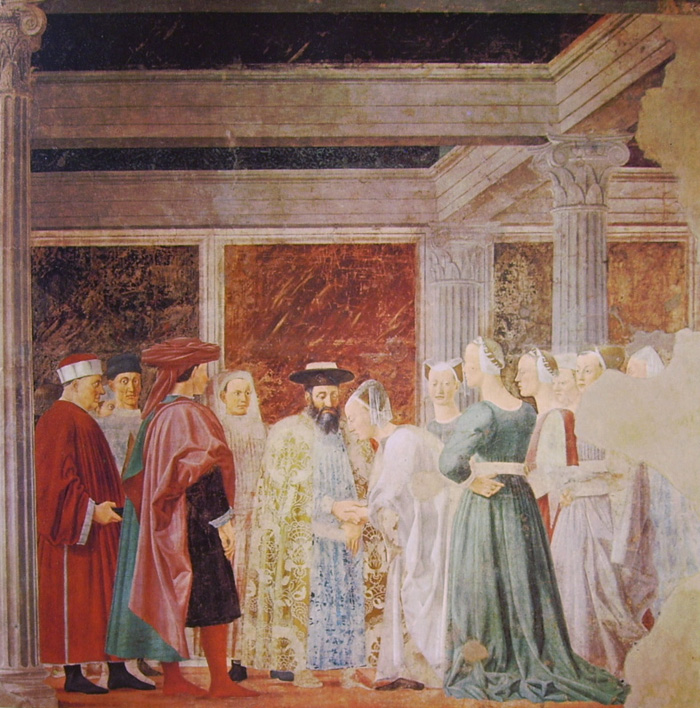
|
Piero della Francesca, Meeting of Solomon and the Queen of Sheba, Basilica di San Francesco, Arezzo
|
|
|
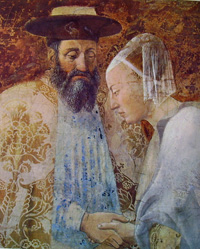 Meeting of Solomon and the Queen of Sheba
|
|
Piero della Francesca, Adoration of the Wood, Basilica di San Francesco, Arezzo
|
|
|
| |
|

|
 |
|
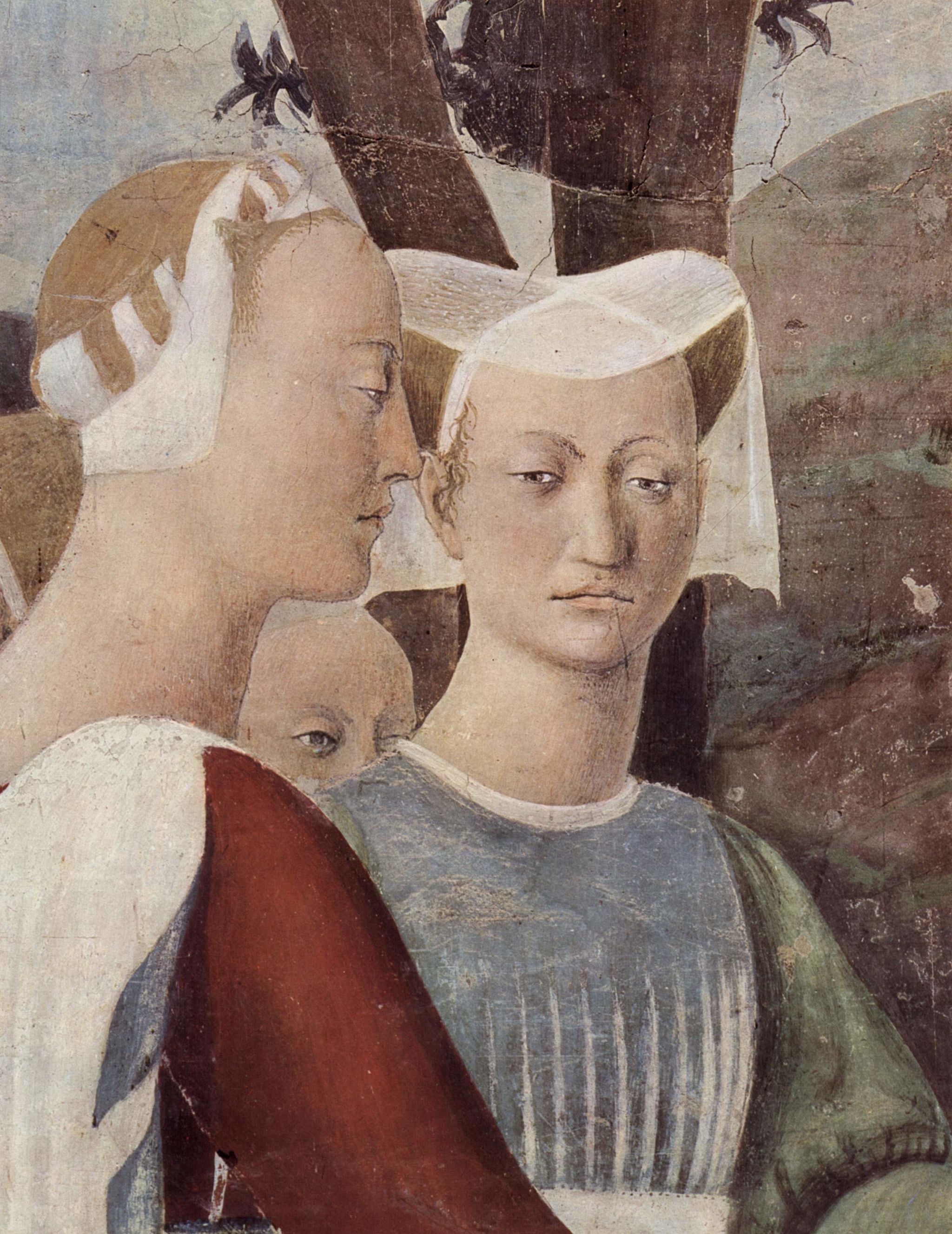 |
|
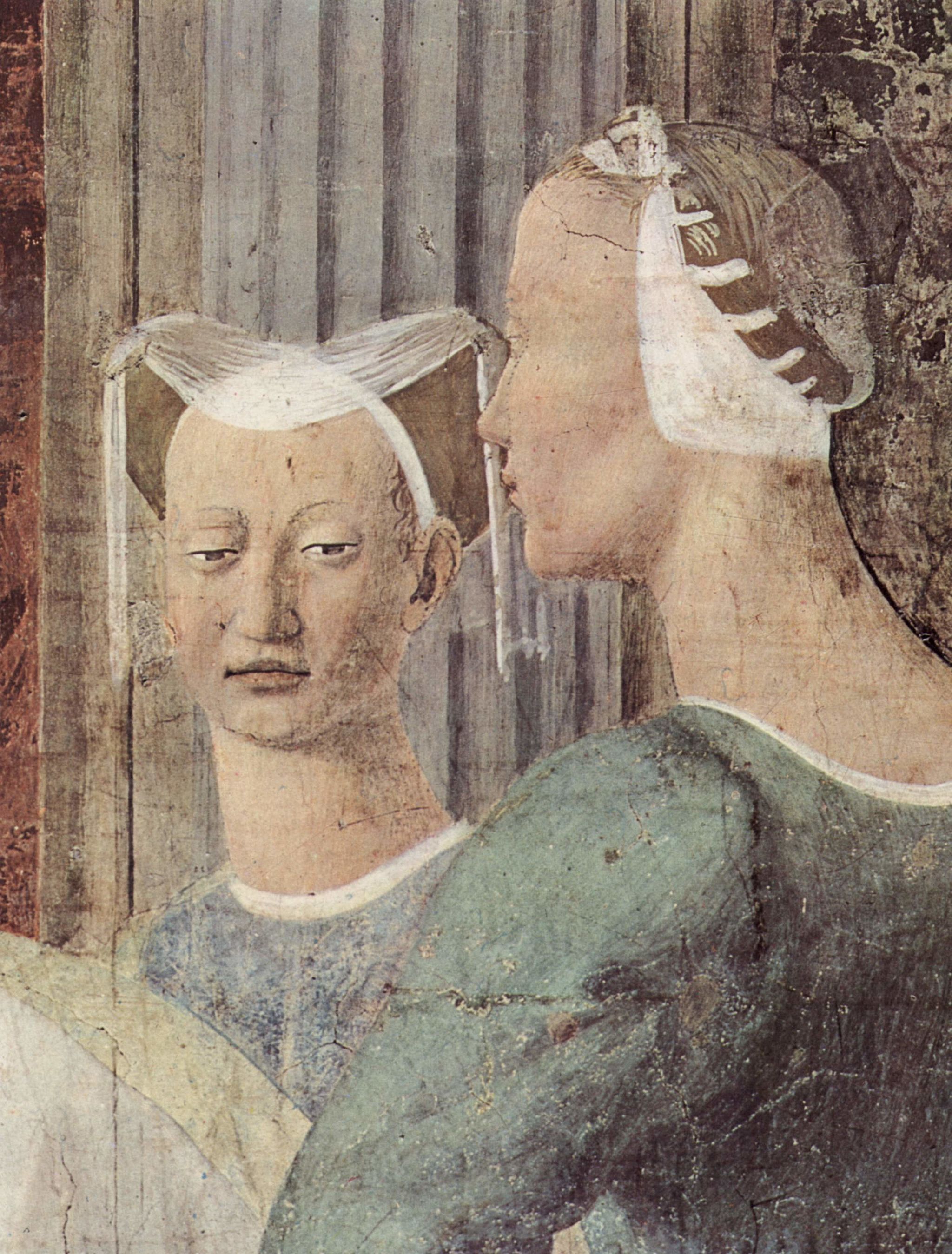 |
| |
|
|
|
|
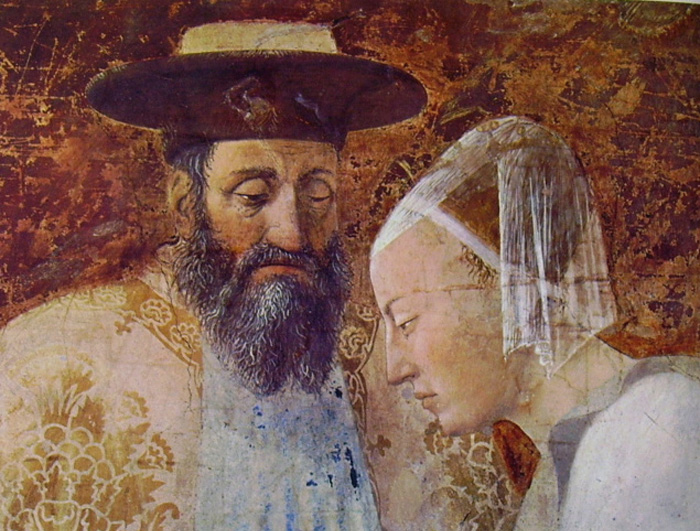 |
Piero della Francesca, Meeting of Solomon and the Queen of Sheba, Basilica di San Francesco, Arezzo
|
|

[1] Travel guide for Tuscany | Piero della Francesca, an itinerary in Tuscany and central Italy
[2] Foto Miguel Hermoso Cuesta - Opera propria, CC BY-SA 4.0, Collegamento
|

Interactive picture | King Solomon and the Queen of Sheba
Giorgio Vasari | Le vite de' più eccellenti architetti, pittori, et scultori italiani, da Cimabue insino a' tempi nostri | Piero della Francesca
Art in Tuscany | Giorgio Vasari's Lives of the Artists | Piero della Francesca
Birgit Laskowski, Piero della Francesca, collana Maestri dell'arte italiana, Gribaudo, Milano 2007.
Attilio Brilli, Borgo San Sepolcro. Viaggio nella città di Piero, Città di Castello, Tibergraph Editrice, 1988.
Luca Madrignani (21-10-2007). Insurrezione e lotta armata a Sansepolcro. Patria Indipendente: pp. 25-27
Il Museo di Piero della Francesca sorge nell’antico Palazzo della Residenza di Sansepolcro, uno dei più rappresentativi di tutta la Toscana. All’interno, su una parete della Sala dei Conservatori, fu affrescata intorno al 1460, più o meno in contemporanea con l’altrettanto famosa Madonna del parto di Monterchi, la celebre Resurrezione, opera, a ragione, definita dallo scrittore inglese Aldous Huxley “la più bella pittura del mondo”. Proprio da questa illustre presenza scaturì, già nel Cinquecento, l’idea di riunire in questa stanza un gruppo di opere d’arte realizzando così la prima collezione artistica cittadina. Questo stesso ambiente oggi, accanto al celebre affresco, conserva le altre opere che Piero eseguì per la sua città natale alla quale rimase sempre legato.
Museo Civico, Via Niccolò Aggiunti, 65, 52037 Sansepolcro Arezzo | www.museocivicosansepolcro.it
.
|
 |
Podere Santa Pia , situata sulle splendide colline del valle d'Ombrone nel cuore della Maremma |
|
|
|
|
|
| |
|
|
|
| |
|
|
|
| |
|
|
|
| |
|
|
|
| |
|
|
|
| |
|
|
|
![]()








